3rd Grade Multiplication Problems
In 3rd grade, students are ready to move beyond addition and subtraction and explore more complex topics, like multiplication. Our creative 3rd grade multiplication problems are designed to help your student build both skills and confidence.

Author
Katie Wickliff
Published:
Aug 2025
Key takeaways
- • After addition and subtraction, multiplication is a natural next step
- • A variety of learning tools and strategies help different types of students
- • Using word problems and riddles help kids stay engaged and interested in learning
In the early elementary years, students focus on mastering basic addition and subtraction, giving them the confidence they’ll need to tackle the next challenge: multiplication.
Multiplication is the foundation for other important math topics like division and fractions. It also sets the stage for success in algebra and other complex concepts in later grades.
If you’re a teacher or parents looking for ways to support your student in multiplication, this article is for you. We explain why multiplication is often introduced in 3rd grade, how it connects to division, and how its role in everyday life. Practicing multiplication frequently and consistently is essential, so you’ll also find 20 sample problems to help your child build skills and boost confidence. For even more ways to support your student, check out Dreambox Math, an online program designed to help your student meet learning goals while still having fun!
Understanding Multiplication in 3rd Grade
In 3rd grade, most students have a solid foundation of addition and subtraction skills, so introducing multiplication is a natural next step. Because of their familiarity with addition, students are ready to see multiplication as repeated addition and understand the concept of equal groups. Developmentally, 3rd graders are developing stronger critical thinking and problem-solving skills, making it easier for them to connect multiplication with the real world, like calculating how much something costs or how many items they need for a group of friends or family.
These higher level thinking skills also allows them to understand how numbers relate to one another– essential for learning division, which they usually encounter soon after. Building multiplication fluency makes division easier, because multiplication combines equal groups to find a total, while division splits the total into equal groups. So, if your child knows that 6 x 2 = 12, they can use that fact to figure out 12 ÷ 2 = 6, or 12 ÷ 6 = 2. Understanding how multiplication and division work together makes learning these concepts less overwhelming.
Table of contents
Get more 3rd grade math practice with DreamBox
10 Real-World Multiplication Word Problems
As parents and teachers know, multiplication is everywhere! These 10 real world multiplication word problems give kids valuable practice while also highlighting how often multiplication appears in everyday scenarios.
1. A football coach has 3 bags of practice footballs for his team. Each bag holds 5 footballs. How many footballs are there in total?
2. Sarah is collecting seashells on the beach. She collects 7 seashells, but her sister collects twice as many. How many seashells do the girls collect in all?
3. Mrs. Brennan’s 3rd grade classroom has 10 tables. Each table can sit 3 students. How many students are in Mrs. Brennan’s class?
4. Skye bakes 4 trays of cookies for the school bake sale. Each tray holds 12 cookies. How many cookies did Skye bake altogether?
5. Connor counts 8 elephants at the safari park, and he counts 4 legs on each elephant. How many legs are there altogether?
6. Merci runs 5 miles every morning. How many miles will she run in 2 weeks?
7. (Challenge) Valentina is counting down the days until Christmas. Since there are 15 weeks left, how many days will she count?
8. (Challenge, 2-step) Lee has 4 boxes of colored pencils. Each box has 6 packs, and each pack contains 8 colored pencils. How many colored pencils does Lee have in all?
9. (Challenge, 2-step) 5 armored trucks are parked outside the bank. Each truck has 6 locked containers inside. Each container has 9 gold bars. How many gold bars are there in trucks altogether?
10. (Challenge, 2-step) A theme park has 8 roller coasters. Each roller coaster has 10 cars. Each car can hold 3 people. How many people can ride the roller coasters at the same time?
10 3rd Grade Multiplication Practice Problems

The math program that drives results
Get started today!
DreamBox adapts to your child’s level and learning needs, ensuring they are appropriately challenged and get confidence-building wins.
4 Ways of Applying Multiplication to Everyday Life
From shopping and cooking to understanding sports scores and even feeding pets, multiplication plays a key role in everyday life. If you want to help your student see how multiplication connects to their world, here are some examples to share::
- Cooking: A “delicious” way to see multiplication in action! When you’re cooking a recipe, challenge your child to double it to feed more people. For example, if a recipe calls for 3 carrots, doubling it means using 3 x 2 carrots– 6 total carrots!
- Sports: Many kids love sports, and watching their favorite team is a great way to practice multiplication. For example, if a football team scores 4 touchdowns at 6 points apiece, multiply 4 x 6 to see that they’ve scored 24 points!
- Pet Food: Challenge your child to figure out how much food they’ll need for their pet over a period of time. For example, if your dog eats 3 cups of food per day, multiply 3 x 7 to figure out that they need 21 cups of food for one week.
- Shopping: Figuring out how much to buy is a great way to make multiplication meaningful! For example, if your child has $24 but wants to buy 5 packs of beads at $5 each, multiplying 5 × 5 shows the total cost is $25 — which means they don’t quite have enough to buy them all.
Answers
Real-World Division Word Problem Answers
- 15 footballs (3 × 5 = 15)
- 21 seashells (7 + 7×2 = 21)
- 30 students (10 × 3 = 30)
- 48 cookies (4 × 12 = 48)
- 32 legs (8 × 4 = 32)
- 70 miles (5 × 14 = 70)
- 105 days (15 × 7 = 105)
- 192 colored pencils (4 × 6 = 24 packs; 24 × 8 = 192)
- 270 gold bars (5 × 6 = 30 containers; 30 × 9 = 270)
- 240 people (8 × 10 = 80 cars; 80 × 3 = 240)
Division Problem Answers
- W
- O
- N
- D
- E
- R
- L
- A
- N
- D
FAQs about 3rd grade Multiplication Problems
The best way to teach multiplication to 3rd graders is by using a variety of strategies and techniques. For example, using fun objects like toys or candy, physical activity, and stories help students understand the concept of equal groups and repeated addition. Highlighting how multiplication appears in their world– through cooking, shopping, or games–makes learning purposeful and engaging. Encouraging plenty of practice at school and at home builds the confidence and skills 3rd graders need to grow as mathematicians.
According to Common Core State Standards, which sets learning guidelines for students in grades K-12, By the end of 3rd grade, students should be able to fluently multiply and divide within 100 and understand the relationship between multiplication and division. By the end of the year, students should also be able to use mental math to multiply 2 one-digit numbers.
Common mistakes students make with multiplication word problems include misreading the question, using the wrong operation, or multiplying the wrong numbers. Students can also struggle with understanding the problem’s context or rushing through their calculations. Encouraging kids to slow down, double check their work, and use drawings or manipulatives can help them tackle word problems with confidence.
Take at home math practice to the next level
Empowering parents and educators to make math practice more impactful. Plus, your kids will love it.

